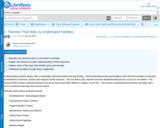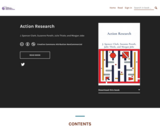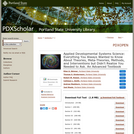
Textbook used in CSI EDUC 204 Families, Communities, and Culture
- Subject:
- Education
- Social Science
- Material Type:
- Textbook
- Author:
- Joshua Halpern
- Rebecca Laff
- Wendy Ruiz
- Date Added:
- 12/01/2022


Textbook used in CSI EDUC 204 Families, Communities, and Culture

Textbook chapter used in CSI EDUC 204 Families, Communities, and Culture.

This Open Educational Resource is an interactive eBook in the form of a website titled ADDIE Explained. The eBook focuses on instructional design from the perspective of the ADDIE Model (Analysis, Design, Development, Implementation, and Evaluation) and is designed for novice instructional designers. ADDIE Explained includes a number of educational and technological affordances designed and developed to assist the learners in comprehending the subject matter.

An interactive approach to conveying the values of academic integrity, clarifying the meaning of plagiarism, and introducing the basics of citations, quoting and paraphrasing.

There is so much to learn when you start university. This book will focus on the most important academic skills you'll need to get started, leaving sufficient 'room' for actual learning and reducing your cognitive load. This book aims to give you a quick understanding of these skills which you can then apply within your area of study. This book aligns to UN Sustainable Development Goal 4 – Quality Education supporting inclusive and affordable access to higher educational resources.

The NSCC Edition is a revised version of the BC Campus Accessibility Toolkit - 2nd Edition. The goal of this book is to provide resources for each content creator, instructional designer, educational technologist, librarian, administrator, and teaching assistant to create a truly open textbook—one that is free and accessible for all students.

This Pressbook contains video training modules for creating accessible content within digital environments and using content authoring programs, such as the Microsoft Office 365 suite and Pressbooks platform. Each section has an optional self-assessment checkpoint for viewers who wish to check their learning progress. Videos have been migrated to permit open-access.

Action research is a common journey for graduate students in education and other human science fields. This book attempts to meet the needs of graduate students, in-service teachers, and any other educators interested in action research and/or self-study. The chapters of this book draw on our collective experiences as educators in a variety of educational contexts, and our roles guiding educator/researchers in various settings. All of our experiences have enabled us to question and refine our own understanding of action research as a process and means for pedagogical improvement.

At any one time, about 300 million children of school going age are not in school. Experience indicates that when schooling is disrupted, whether by a pandemic, a natural disaster or other reasons, not all children return to the classroom. In addition, most countries have growing numbers of young people who have not completed schooling, or not well enough to progress, and who find themselves neither in employment nor in further education and training.
Open schooling can create learning opportunities for those not in school, those who left school and those who are in school but not learning effectively. There is no single model for open schooling provision which might offer a complementary or alternative curriculum, or both. However, all models can benefit from greater use of open educational resources; open, distance and flexible methods and open educational practices. In this way it is possible to address issues of access, quality and affordability in a sustainable way.
This book offers guidelines and examples that will be of use to teachers, managers, policy-makers and education leaders interested to ensure that the education system meets the needs of all children and youths.

Textbook for Adolescent Psychology course

VCCS's "Pathways" Course provides faculty with an introduction to the laws that influence the use, re-use, and distribution of content they may want to use in a course. Activities include finding openly licensed content for use in a class and publishing openly licensed works created by faculty. At the end of the course, students will have openly licensed content that will be ready for use in a course.

The second edition is an updated and expanded version of the original adoption guide. The first sections address three distinct groups involved in open textbook adoption: instructors, post-secondary institutions, and students. The second--most comprehensive--section focuses on the operational aspects of adoption: surveying instructors about, tracking usage of, and reporting out about open textbooks (and other OER). The last "Learn More" part provides additional adoption information.

: Fundamental mathematics for adult learners. Book 3 includes a Table of Contents, Glossary, Grades Records, Self Tests, Practice Tests and Unit Tests. Ancillary Resources include the Instructor's Manual. This is 1 of a series of 6 books in the ABE Math collection.

: Fundamental mathematics for adult learners. Book 5 includes a Table of Contents, Glossary, Grades Records, Self Tests, Practice Tests and Unit Tests. Ancillary Resources include the Instructor's Manual. This is 1 of a series of 6 books in the ABE Math collection.

: Fundamental mathematics for adult learners. Book 6 includes a Table of Contents, Glossary, Grades Records, Self Tests, Practice Tests and Unit Tests. Ancillary Resources include the Instructor's Manual. This is 1 of a series of 6 books in the ABE Math collection.

Course Description:
In this course, participants will focus on creating engaging materials for their courses. Different forms of engagement will be explored and content created that is relevant to the courses that they teach.
Learning Outcomes:
Create engaging discussion forums. (LO1)
Design new content for current courses. (LO2)
Investigate new forms of media to engage students. (LO3)

OER Fundamentals are invited to remix this course planning template to design and share their OER project plans, course information and syllabus, and reflection.

Algebra and Trigonometry 2e provides a comprehensive exploration of mathematical principles and meets scope and sequence requirements for a typical introductory algebra and trigonometry course. The modular approach and the richness of content ensure that the book addresses the needs of a variety of courses. Algebra and Trigonometry 2e offers a wealth of examples with detailed, conceptual explanations, building a strong foundation in the material before asking students to apply what they’ve learned.Attribution: This work "Algebra and Trigonometry, 2e" by Jay Abramson is licensed under a Creative Commons Attribution 4.0 International License, except where otherwise noted.

This course is an introduction to the design and development of instruction using educational media and technology. It involves development of teaching and learning materials using digital technologies, contemporary applications of computers and other electronic systems to instruction. Because this is a preservice education course, the main focus is on effective integration of educational technology and instructional design. This is a semester-long course that is taught face-to-face and aims not only to model excellence in teaching with technology but also to provide a safe environment within which preservice teachers work in teams to facilitate active and engaged peer learning that reflects best practices in technology integration, instructional design, content presentation, instructional strategies, standards-based assessment, and lesson reflection. You will experience true student-centered learning in this class with your instructor modelling the role of facilitator.

This textbook provides a toolbox, a guidebook, and an instruction manual for researchers and interventionists who want to conceptualize and study applied problems from a developmental systems perspective, and for those who want to teach their graduate (or advanced undergraduate) students how to do this. It is designed to be useful to practitioners who focus on applied developmental problems, such as improving the important developmental contexts where people live, learn, and work, including the applied professions in education, social work, counseling, health care, community development, and business, all of which at their core are concerned with optimizing the development of their students, clients, patients, workers, citizens, and others whose lives they touch.